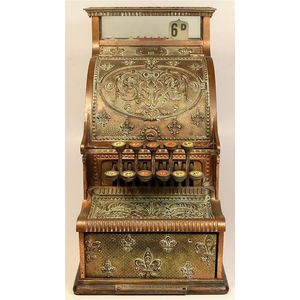Victorian Coromandel Desk Standish with Ink Wells and Drawer
You must be a subscriber, and be logged in to view price and dealer details.
Subscribe Now to view actual auction price for this item
When you subscribe, you have the option of setting the currency in which to display prices to $Au, $US, $NZ or Stg.
- Victorian Period - The Victorian period of furniture and decorative arts design covers the reign of Queen Victoria from 1837 to 1901. There was not one dominant style of furniture in the Victorian period. Designers used and modified many historical styles such as Gothic, Tudor, Elizabethan, English Rococo, Neoclassical and others, although use of some styles, such as English Rococo and Gothic tended to dominate the furniture manufacture of the period.
The Victorian period was preceded by the Regency and William IV periods, and followed by the Edwardian period, named for Edward VII (1841 ? 1910) who was King of the United Kingdom and the British Dominions and Emperor of India for the brief period from 1901 until his death in 1910. - Calamander / Coromandel - Calamander wood, also known as coromandel wood or coromandel ebony, is a type of hardwood that comes from the Calamander tree (Diospyros quaesita), which is native to Sri Lanka, India, and Southeast Asia. The wood is known for its dark brown or black colour and its distinctive figuring, which can resemble a snakeskin pattern.
The wood is highly prized for its beauty and durability. It is often used in fine furniture making, particularly in the production of inlaid and marquetry work, as well as in the making of boxes, cabinets, and other decorative items. It is also used in the manufacture of flooring, paneling and other architectural applications.
Calamander wood is a very hard and heavy wood, it has a density of around 1.04 g/cm3. Its density and high natural oil content make it resistant to decay and insects, which is why it is a popular choice for outdoor furniture, flooring and other decorative items.
The wood is also used for turning and carving, but is difficult to work due to its high density and interlocking grain. However, it takes a high natural polish and has a beautiful lustre, which is why it is so sought after.
Due to the high demand and over-exploitation of the natural resources, the calamander tree is now a protected species, and the harvesting and export of the wood is heavily regulated. - Standish - Although the word is little used nowadays, a standish is an inkstand on feet and usually in silver or silver plate, containing some of the following: inkwells, a pounce pot, a sealing wax container and a pen rest. Standishes are also found in less common materials including boulle, marble, brass and wood.
This item has been included into following indexes:
- desk standish (inkstand) 60
- ink stands - silver plate items 80
-
ink wells / ink stands, material
- brass 95
- silver items 303
- silver plate items 84
- ink wells / ink stands, period or age - Victorian 86
Visually similar items

A brass Congreve rolling ball clock, the four-pillar frame with tilting table to accommodate the balls surmounted by the skeleton fusee movement with three enamel annular dials, raised on a 'Sorrento' inlaid walnut plinth base with drawer and enclosed with

Chinoiserie long case grandfather clock, with German Tempus Fugit weight driven striking movement, 205 cm high

American cash register by the National Cash Register Company Dayton, Ohio. Serial number 772788 210. Height 42 cm

Two repousse silver Hindu plaques, including Vishnu and krishna approx, 12 cm high
